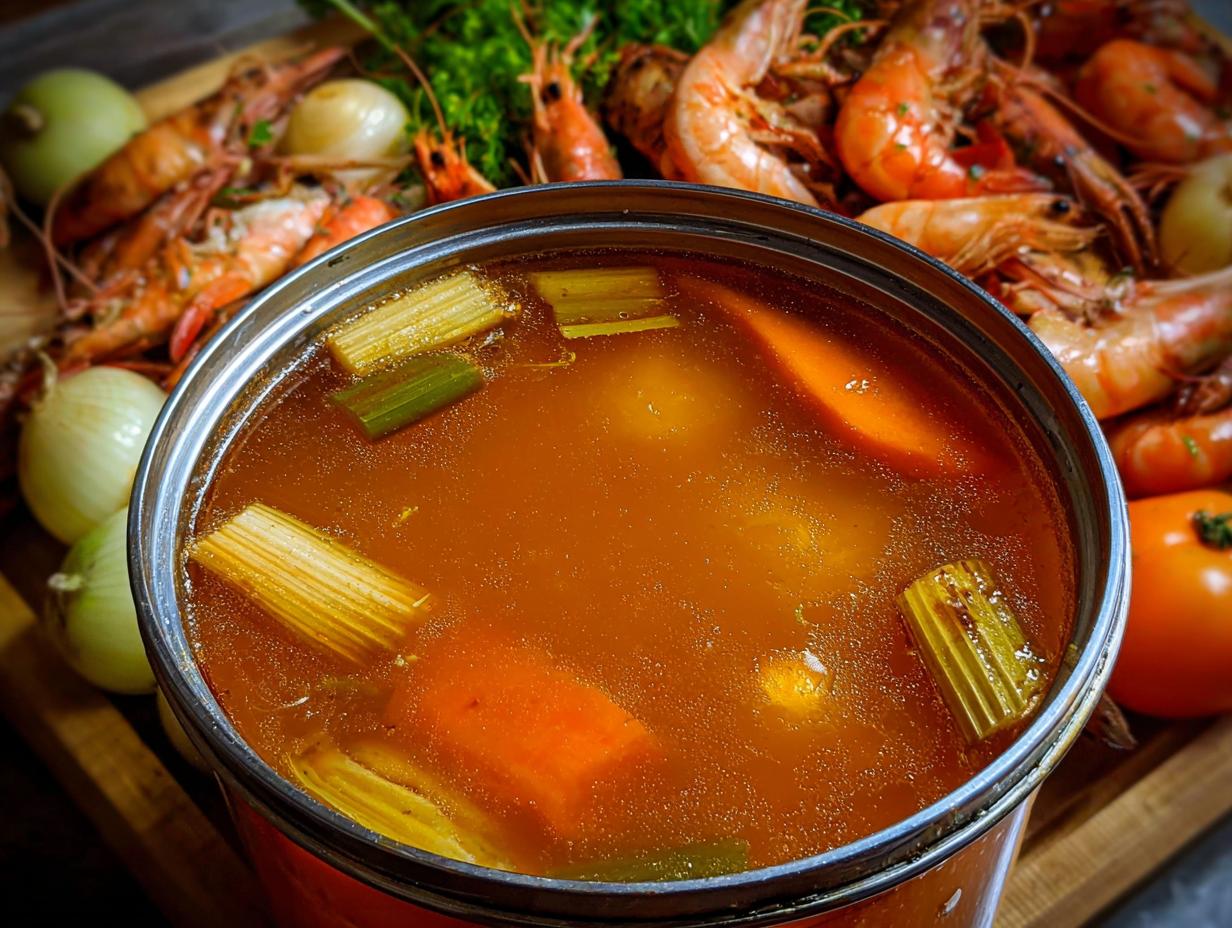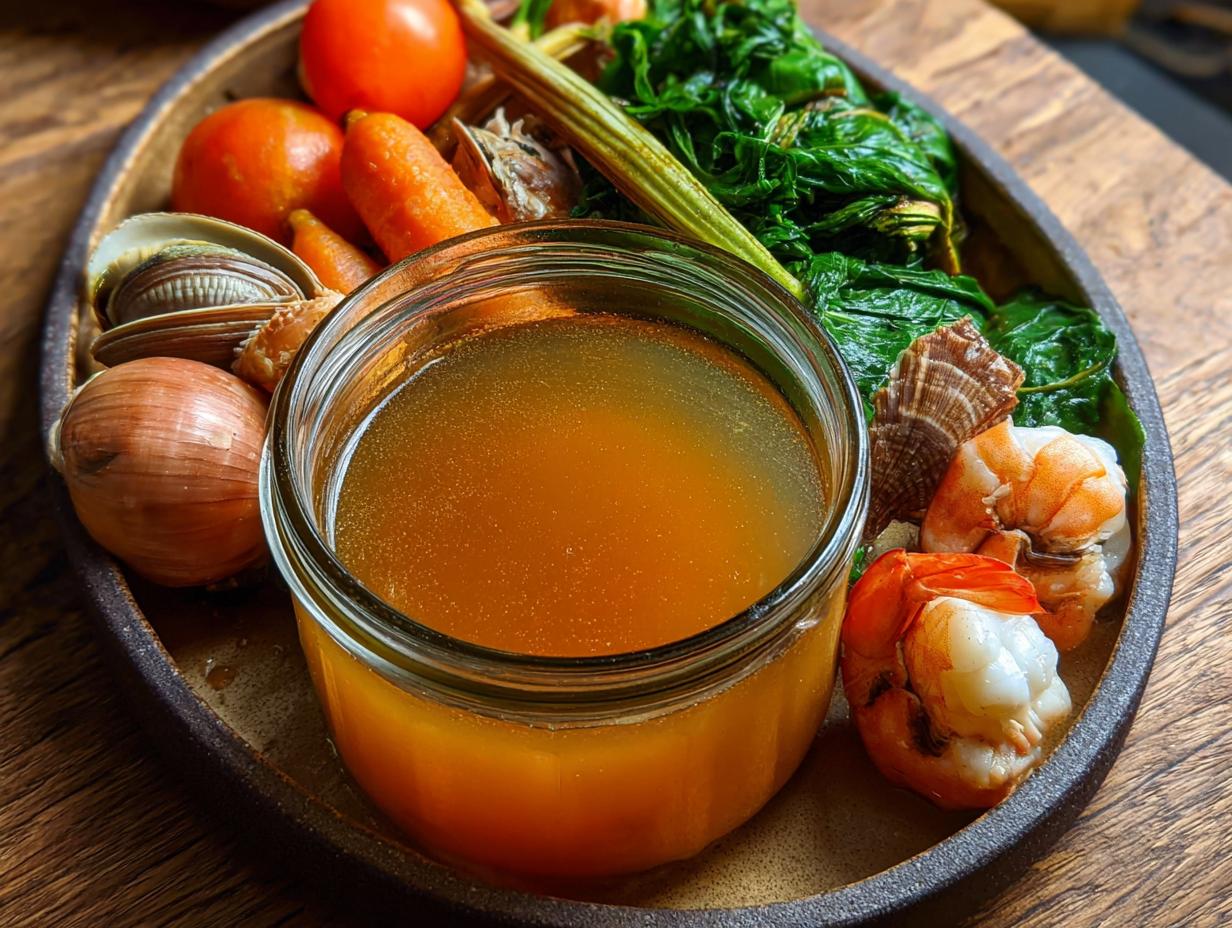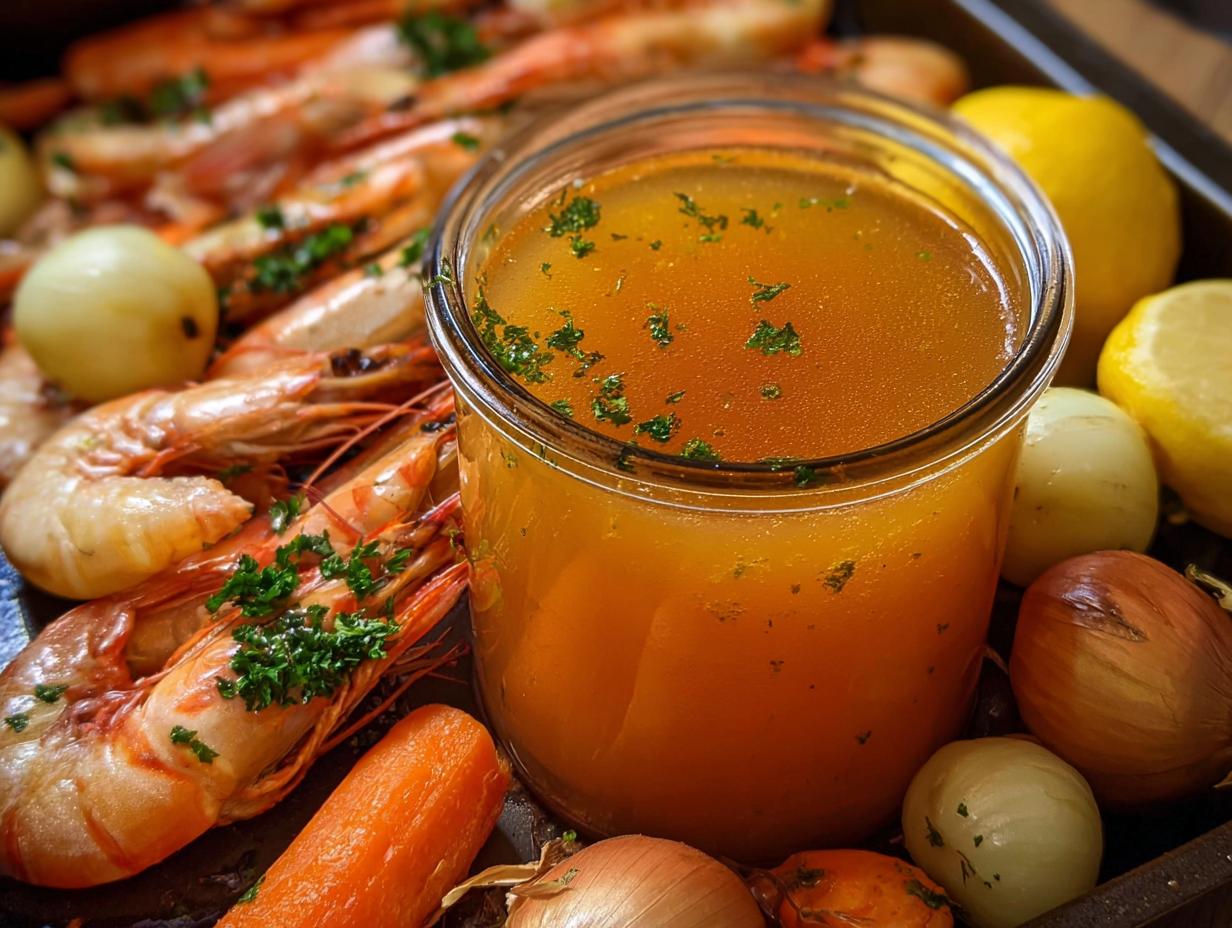Seafood stock has been my secret weapon for elevating weeknight meals and impressing guests for years. I still remember my first attempt at making it from leftover shrimp shells after a special dinner; the aroma that filled my kitchen was incredible, a promise of the deep, briny flavor to come. It’s amazing how those humble shells can transform into something so rich and versatile. Forget those watery store-bought versions – this homemade foundation is pure liquid gold for any dish. Let’s get cooking!
What is Seafood Stock?
So, what is seafood stock? Think of it as the flavorful essence of the sea, captured in a liquid. It’s essentially a simmering liquid made from fish bones, shellfish shells, and aromatic vegetables like onions, carrots, and celery. Unlike a quick fish stock, this richer seafood broth often involves longer simmering to extract maximum flavor from bones and shells. It’s the unsung hero in many delicious dishes, providing a deep, briny foundation that store-bought versions just can’t match.
This versatile liquid is crucial for adding depth and authenticity to everything from delicate bisques and hearty chowders to elegant sauces and perfectly seasoned risottos. It’s the secret ingredient that makes seafood dishes sing!
Why You’ll Love This Homemade Seafood Stock
You’re going to adore making this homemade seafood stock. It’s packed with benefits that go way beyond just great taste. Here’s why you should start using it:
- Unbeatable Flavor: It adds an incredible depth and authentic taste of the sea that store-bought options can’t replicate. This is why use seafood stock in so many of my favorite recipes.
- Cost-Effective: You’re essentially using leftover shells – a fantastic way to save money compared to buying pre-made stocks or broths.
- Reduces Waste: It’s a brilliant way to use up those shrimp, crab, or lobster shells you might otherwise throw away.
- Incredibly Versatile: From soups and stews to sauces and risottos, this stock elevates countless dishes.
- Simple to Make: Don’t be intimidated! This recipe is straightforward and yields amazing results with minimal effort.
- Healthier Choice: You control the ingredients, avoiding excess sodium and preservatives found in many commercial products.
- Superior Base: It provides a richer, more nuanced foundation for your cooking than a basic fish stock.
Ingredients for the Best Seafood Stock
Gathering your fish stock ingredients is the first step to creating a truly exceptional seafood base recipe. I find that using a mix of shells, like shrimp, crab, or lobster, gives the most complex and briny flavor, but feel free to use what you have on hand! Don’t forget the aromatics – they’re key to building a well-rounded flavor profile and preventing any gamey taste.
- 2 tablespoons olive oil – to get our aromatics nice and softened
- 1 yellow onion, chopped – for a touch of sweetness
- 2 carrots, chopped – adds a subtle earthy note and color
- 2 celery stalks, chopped – brings a fresh, slightly peppery flavor
- 4 cloves garlic, minced – because garlic makes everything better!
- 1 pound mixed seafood shells (shrimp, crab, lobster) – the stars of our show for that deep sea flavor
- 2 tablespoons tomato paste – deepens the color and adds umami
- 1/4 cup cooking sherry or dry white wine – for deglazing and adding a layer of complexity
- 8 cups water – the base for our simmering stock
- 1 bunch parsley stems – adds a clean, fresh herbaceousness
- 2 sprigs fresh tarragon or 1 teaspoon dried – a subtle anise note that pairs beautifully with seafood
- 2 bay leaves – classic aromatics for depth
- 1 teaspoon whole black peppercorns – for a gentle warmth
How to Make Seafood Stock From Scraps
Learning how to make seafood stock from scraps is incredibly rewarding, and this method ensures you get the most flavor possible. It’s all about building layers of taste, starting with those humble shells and aromatic veggies. This process of making fish stock at home is simpler than you might think, and the payoff in flavor is immense.
- Step 1: Grab a large, heavy-bottomed pot or Dutch oven and heat 2 tablespoons of olive oil over medium heat. Toss in your chopped 1 yellow onion, 2 carrots, and 2 celery stalks. Sauté them for about 5 minutes, stirring occasionally until they start to soften and get a little bit of color. This step is crucial for developing a sweet flavor base.
- Step 2: Add your pound of mixed seafood shells – think shrimp, crab, or lobster – to the pot. Keep stirring them around for another 5 minutes. You’ll start to smell that lovely seafood aroma as the shells begin to toast slightly.
- Step 3: Stir in the 2 tablespoons of tomato paste. Cook for just 1 minute, stirring constantly, until it darkens a bit. This really deepens the umami flavor and adds a beautiful reddish hue to your stock.
- Step 4: Pour in the 1/4 cup of dry white wine or cooking sherry. Use a wooden spoon to scrape up any browned bits stuck to the bottom of the pot – that’s pure flavor gold! Let it bubble and reduce for about 1-2 minutes.
- Step 5: Now, add the 8 cups of water. Toss in the parsley stems, tarragon (fresh or dried), 2 bay leaves, and 1 teaspoon of whole black peppercorns. Give everything a good stir and bring the mixture to a gentle simmer.
- Step 6: Let the stock simmer uncovered for about 30 minutes. Keep an eye on it and skim off any foam or impurities that rise to the surface. This helps keep your stock clear and clean-tasting. You’ll notice a wonderful, briny aroma filling your kitchen.
- Step 7: Once simmering is complete, carefully remove the pot from the heat. Let it cool slightly for about 10-15 minutes before straining.
- Step 8: Place a fine-mesh sieve over a large bowl or clean pot. Carefully pour the stock mixture through the sieve. Press down on the solids with the back of a spoon to extract as much liquid as possible. Then, discard the solids.
- Step 9: Allow your beautifully golden seafood stock to cool completely before storing it.

Pro Tips for the Best Homemade Fish Stock
Making a truly superior homemade fish stock is all about attention to detail. A few simple tricks can elevate your stock from good to absolutely spectacular, ensuring it tastes like it came from a fine French restaurant. Follow these tips for the best results every time you whip up this essential kitchen staple.
- Rinse shells well: Always rinse your seafood shells thoroughly under cold water to remove any grit or unwanted debris before you start cooking.
- Don’t use oily fish: Oily fish like salmon or mackerel can make your stock bitter. Stick to white fish bones or shellfish for the cleanest flavor.
- Skim diligently: As the stock simmers, regularly skim off any foam or impurities that rise to the surface. This keeps your stock clear and pure.
- Simmer, don’t boil: A gentle simmer is key. Boiling can make the stock cloudy and can extract bitter flavors from the shells.
What’s the secret to perfect seafood stock?
The secret to a perfect seafood stock for soup lies in browning the shells and aromatics first. This caramelization adds incredible depth and a rich, savory flavor that you just can’t achieve with raw ingredients. It’s a simple step that makes a huge difference! For more on flavor development in cooking, check out this guide on how to brown ingredients.
Can I make seafood stock ahead of time?
Absolutely! This is a fantastic make-ahead component for your cooking. Once cooled, you can store your seafood stock in airtight containers in the refrigerator for up to 3-4 days, or freeze it for longer storage. You can find more make-ahead meal ideas here.
How do I avoid common mistakes when making fish stock?
The biggest mistake is using oily fish, which can make the stock taste bitter. Also, avoid over-simmering; 30 minutes is usually plenty. Boiling vigorously instead of gently simmering can also lead to a cloudy, less refined flavor.
Seafood Stock Uses and Serving Suggestions
Now that you’ve mastered how to make seafood stock, let’s talk about all the amazing ways you can use it! This rich, briny liquid is a game-changer for so many dishes. I love using it as the base for a creamy seafood chowder or a luxurious seafood risotto. Just imagine the depth of flavor it adds to a simple pan sauce for grilled fish!
The seafood stock uses are practically endless. It’s perfect for building the foundation of bisques, enhancing the flavor of paella, or even deglazing a pan after searing scallops. You’ll find yourself reaching for this homemade stock again and again to elevate your favorite seafood creations. For more recipe inspiration, check out our latest recipes.
Variations of Seafood Stock
While this recipe provides a fantastic foundation, you can easily adapt it to create different types of seafood stock. Exploring these variations allows you to tailor the flavor profile to your specific dish. For instance, a dedicated shellfish stock recipe using only crab or lobster shells will yield an intensely sweet and rich broth, perfect for bisques. If you’re looking for something lighter or want to incorporate more vegetables, a vegetable fish stock can be made by significantly increasing the vegetable components and using fewer or no shells, though it won’t have the same deep, briny flavor.
You can also create a lighter fish fumet by using only fish bones (from white fish, avoiding oily ones) and fewer aromatics, simmered for a shorter time – this is excellent for delicate sauces. Remember, the goal is always to capture the essence of the seafood, whether it’s from shells, bones, or a combination.
Nutrition Facts for Seafood Stock
When you make your own seafood stock, you get a wonderfully flavorful base without a lot of unhealthy additions. Here’s a general idea of the nutritional breakdown per cup, though keep in mind that exact figures can vary based on the specific shells and vegetables you use. This homemade broth is a lighter option compared to many other cooking liquids.
- Calories: 50
- Fat: 2g
- Saturated Fat: 0.5g
- Unsaturated Fat: 1.5g
- Trans Fat: 0g
- Carbohydrates: 5g
- Fiber: 1g
- Sugar: 3g
- Protein: 3g
- Sodium: 150mg
- Cholesterol: 10mg
Nutritional values are estimates and may vary based on specific ingredients used.
How to Store and Reheat Seafood Stock
Properly storing your flavorful homemade fish broth is key to keeping it fresh and ready for your next culinary adventure. Once your beautiful seafood stock has cooled completely (this is super important to prevent bacterial growth!), transfer it into airtight containers. For immediate use within 3-4 days, glass jars or sturdy plastic containers work perfectly for refrigeration. This makes grabbing a portion for a quick sauce or soup base super convenient.
If you’re not using it right away, freezing is your best friend! You can freeze your seafood broth in ice cube trays for small portions – perfect for adding a flavor boost to individual servings of pasta or grains. For larger quantities, freezer bags laid flat or freezer-safe containers are ideal. It will keep well in the freezer for up to 3 months. When you’re ready to use it, thaw overnight in the refrigerator or gently reheat it on the stovetop over low heat until warmed through.
Frequently Asked Questions About Seafood Stock
What is the difference between seafood stock and fish fumet?
A fish fumet recipe is typically made with fish bones and is simmered for a shorter period, usually around 20-30 minutes, resulting in a lighter, more delicate flavor. Our seafood stock often uses a mix of shellfish shells and fish bones, and may simmer a bit longer to extract a richer, deeper flavor, making it more versatile for a wider range of dishes.
How do I make seafood broth from scraps effectively?
To effectively make seafood broth from scraps, start by rinsing all your shells thoroughly. Sauté your aromatics like onions, carrots, and celery until softened, then add the shells and toast them briefly. Deglazing with a bit of wine or sherry adds depth. Use plenty of water and simmer gently for about 30 minutes, skimming any impurities. Strain well and cool completely.
Can I use any type of seafood shells for this stock?
While you can use most seafood shells, it’s best to avoid oily fish bones like salmon or tuna, as they can impart a bitter taste. Shrimp, crab, and lobster shells are excellent choices for a rich, flavorful stock. Combining different types can create a more complex and delicious base for your cooking.
What are some quick uses for homemade seafood stock?
This stock is fantastic for quick sauce bases – deglaze a pan after searing fish or scallops and add a splash of stock. It’s also perfect for enriching simple pasta dishes, adding depth to grain bowls, or creating a flavorful base for quick seafood soups or ramen. It truly elevates everyday meals with minimal effort.
Print
Seafood Stock: Amazing 30-min Flavor Bomb
- Total Time: 55 minutes
- Yield: Approximately 7-8 cups 1x
- Diet: Vegetarian
Description
Learn how to make rich and flavorful homemade seafood stock using shrimp, crab, or lobster shells and aromatic vegetables. This versatile seafood base is perfect for enhancing soups, stews, bisques, and sauces, adding a deep, briny essence to your favorite seafood dishes. It’s a fantastic way to use leftover shells and elevate your cooking.
Ingredients
- 2 tablespoons olive oil
- 1 yellow onion, chopped
- 2 carrots, chopped
- 2 celery stalks, chopped
- 4 cloves garlic, minced
- 1 pound mixed seafood shells (shrimp, crab, lobster)
- 2 tablespoons tomato paste
- 1/4 cup cooking sherry or dry white wine
- 8 cups water
- 1 bunch parsley stems
- 2 sprigs fresh tarragon or 1 teaspoon dried
- 2 bay leaves
- 1 teaspoon whole black peppercorns
Instructions
- Heat olive oil in a large pot or Dutch oven over medium heat. Add onion, carrots, and celery. Cook for 5 minutes, stirring until lightly browned.
- Add seafood shells to the pot. Cook for 5 minutes more, stirring occasionally.
- Stir in tomato paste and cook for 1 minute until it darkens.
- Pour in the cooking sherry or white wine to deglaze the pot, scraping up any browned bits from the bottom. Simmer for 1-2 minutes.
- Add water, parsley stems, tarragon, bay leaves, and peppercorns. Bring the mixture to a gentle simmer.
- Cook uncovered for 30 minutes, skimming off any foam that rises to the surface.
- Remove from heat. Let the stock cool slightly.
- Strain the stock through a fine-mesh sieve into a clean bowl or pot. Press down on the solids to extract as much liquid as possible. Discard the solids.
- Allow the seafood stock to cool completely before storing.
Notes
- Rinse shells thoroughly before using to remove any dirt or debris.
- Avoid using oily fish like salmon, mackerel, or tuna, as their bones can make the stock bitter.
- Do not over-simmer the stock, as this can lead to a bitter or muddy flavor. 30 minutes is sufficient.
- You can mix and match different types of seafood shells for a more complex flavor.
- For easier portioning, freeze the cooled stock in ice cube trays or freezer bags.
- Prep Time: 15 minutes
- Cook Time: 40 minutes
- Category: Kitchen Basics & How To
- Method: Simmering
- Cuisine: American
Nutrition
- Serving Size: 1 cup
- Calories: 50
- Sugar: 3g
- Sodium: 150mg
- Fat: 2g
- Saturated Fat: 0.5g
- Unsaturated Fat: 1.5g
- Trans Fat: 0g
- Carbohydrates: 5g
- Fiber: 1g
- Protein: 3g
- Cholesterol: 10mg
Keywords: Seafood Stock, Seafood Broth, Fish Stock Recipe, Homemade Fish Stock, How to Make Seafood Stock, Best Seafood Stock, What is Seafood Stock, Fish Fumet Recipe, Seafood Base Recipe, How to Make Fish Stock From Scraps, Homemade Fish Broth, Seafood Stock for Soup, Why Use Seafood Stock, Making Fish Stock at Home, Shellfish Stock Recipe, Best Homemade Fish Stock, Seafood Stock for Risotto, How to Make Seafood Broth, Fish Stock Ingredients, Seafood Stock Uses, Vegetable Fish Stock









